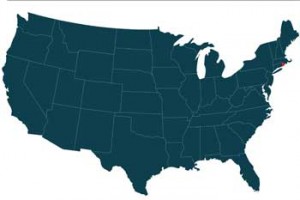Rhode Island Emergency Vehicle Light State Statutes
 Vehicles driving through Rhode Island to respond to emergencies or perform roadside services have the opportunity to identify themselves with flashing lights. Depending on the vehicle, these flashing lights can require other vehicles to move over or just help to alert and caution surrounding vehicles. All of the Rhode Island requirements for emergency vehicle lights are clearly laid out in the state statutes within title 31 of Rhode Island law. Rhode Island has many colors available for auxiliary lighting, including red, white, blue, and amber. You can discover the colors, placement, and shapes required for various departments by reading this article.
Vehicles driving through Rhode Island to respond to emergencies or perform roadside services have the opportunity to identify themselves with flashing lights. Depending on the vehicle, these flashing lights can require other vehicles to move over or just help to alert and caution surrounding vehicles. All of the Rhode Island requirements for emergency vehicle lights are clearly laid out in the state statutes within title 31 of Rhode Island law. Rhode Island has many colors available for auxiliary lighting, including red, white, blue, and amber. You can discover the colors, placement, and shapes required for various departments by reading this article.
Police lights
Rhode Island regulates the state's police lights with statute 31-24-31 and says that police cars are the only vehicles allowed to use blue lights. All police units, both state and local can use flashing or rotary lights. They have the option of using a center rotating beam in blue or red, and they can also mount lights along their outboard in either blue or red. Any flashing lights must flash simultaneously instead of alternately. All police lights for Rhode Island police vehicles need to be visible from at least 500 feet in the distance during the sunlight. These laws apply to both marked police cars and unmarked police vehicles. In order to use lights associated with the police department, a car must be a registered vehicle for a police department.
Fire truck lights
Statute 31-24-31 also provides details about what sort of lights are allowed on fire truck vehicles. A fire truck emergency response vehicle is any vehicle used by the fire department and rescue department, or any vehicle used by the fire chief, assistant fire chief, deputy chief, or captain for a fire department. These vehicles should only use lighting when responding to an emergency. The lighting they are allowed to use include red flashing lights, white flashing lights, and lights that alternate between red and white while flashing.
Volunteer firefighter lights
As statute 31-1-3 explains, any volunteer firefighter is considered to be an authorized emergency vehicle as long as they are authorized by one of the Rhode Island fire departments. Therefore, they have the opportunity to use the lighting for a standard Rhode Island fire truck on their own privately owned vehicle. This lighting consists of red and white flashing lights. Volunteer firefighters can choose to use just red flashing lights, just white flashing lights, a combination of red and white flashing lights, or a light that alternates between red and white.
Ambulance light
According to statute 31-24-31, ambulances fall under the category of emergency response vehicles. This category includes vehicles for the ambulance department, medical examiners, forensic pathologists, American Red Cross disaster vehicles, and hospital emergency response vehicles. All of these various types of ambulances use red and white flashing lights. They can use any desired combination of red flashing lights, white flashing lights, and lights that alternate between red and white as they flash.
Tow trucks lights
Statute 31-24-31 of Rhode Island law allows all types of roadside assistance vehicles to use flashing lights to alert other motorists to their vehicle. The flashing lights must be an amber color, and they can be mounted at both the front and the rear of the vehicle. These lights are only allowed to be activated while providing assistance or transporting a disabled vehicle. The tow truck driver will need to fill out a flashing tow truck light permit application at the division of motor vehicles in order to get a permit to equip their vehicles, and they will need to pay a fee of $25.
Construction vehicle lights
 Roadside construction vehicles, snowplows, and tractors all fall under the statute 31-24-31 regulations. This means that they are allowed to install a set of flashing amber lights on their vehicle to make themselves more visible. The lights can be placed on the front, back, or both ends of the vehicle as desired. As statute 31-24-31 explains, construction vehicles must visit the Division of Motor Vehicles, pay a fee, and fill out a form to get their permit. Once they have the permit and the lights, they may turn them on any time the vehicle is operating in its construction function.
Roadside construction vehicles, snowplows, and tractors all fall under the statute 31-24-31 regulations. This means that they are allowed to install a set of flashing amber lights on their vehicle to make themselves more visible. The lights can be placed on the front, back, or both ends of the vehicle as desired. As statute 31-24-31 explains, construction vehicles must visit the Division of Motor Vehicles, pay a fee, and fill out a form to get their permit. Once they have the permit and the lights, they may turn them on any time the vehicle is operating in its construction function.
Utility vehicle lights
Lights for light companies, telephone companies, water companies, oil companies, and any other utility can all use the same lights. The lighting system that utility vehicles can use are amber lights on the front and back of their vehicle. These lights can be flashing lights, but they cannot be strobe lights. According to Rhode Island statute 31-24-31, utility vehicles will need to get a permit from the Division of Motor Vehicles. If the utility vehicle is a town or fire district maintenance vehicle, they do not have to pay the $25 fee that other utility vehicles have to pay.
Pilot vehicle light
Rhode Island does not specifically have any laws in place surrounding the escort vehicles that help to alert the public to an oversized load. However, the Rhode Island Secretary of State manual for oversized and overweight loads specifies that escort vehicles should use flashing yellow lights that are not strobe lights. These lights should be placed above the highest part of the vehicle, and they need to be visible from both the front and the rear.
Security Vehicle Lights
Rhode Island rules for security vehicles will vary depending on where the vehicle is driving and what type of vehicle is providing the security. Any town or state safety vehicles are allowed to use the lighting specified in statute 31-24-31. This is flashing amber lights on the front or rear of the vehicle. However, if the vehicle is privately owned and driving on a public road, it may not use any flashing lights. The laws do not apply to vehicles that are driving on a private area. This means that a security vehicle patrolling a mall parking lot or other privately owned region can have whatever sort of lighting system it prefers. Some companies may prefer to use top mounted amber lights or green flashing lights.
For more information about what lights may be available to you, we suggest calling your State Highway Patrol office at: 401-444-1000
*Please note that these numbers are what we are currently able to find and the numbers may have changed since this listing.
Disclaimer: The emergency vehicle light state statute guide was created by Extreme Tactical Dynamics as a guide and reference. We make no claim to the accuracy or validity of this guide. This guide was written to the best of our knowledge and has been provided to our customers as a courtesy ONLY! The information in this guide is our interpretation of the law as we have read it. We cannot be held responsible for any errors as this is only our interpretation of the law and the laws are constantly changing. We cannot be held liable or responsible for any errors and recommend that our customers refer to their local authorities to confirm the particular statue that governs their use of emergency vehicle lights.
 Facebook
Twitter
Google+
Instagram
YouTube
Facebook
Twitter
Google+
Instagram
YouTube


